Latest Event Updates
Il nuovo regolamento 2023
Si è appena concluso il mondiale di rugby con la vittoria del Sudafrica. Il suo gioco difensivo, asfissiante, cinico ha avuto la meglio sui fenomeni all-blacks. Una finale, a mio parere, tra le più belle delle ultime edizioni. Nel frattempo, per festeggiare insieme a tutti gli appassionati di tablerugby, abbiamo pubblicato la nuova edizione del regolamento. La trovate alla pagina del regolamento oppure direttamente a questo link: Regolamento 2023
Intanto gustatevi la foto
La squadra dell’uomo con la maglietta verde ha vinto di un punto (probabilmente immeritatamente e con un paio di decisioni arbitrali discutibili). La squadra dell’uomo con la maglietta nera ha perso di un punto vedendosi una meta annullata. Questo è lo sport degli uomini.

Ho chiesto a ChatGpt di parlarmi di subbuteo rugby
Subbuteo Rugby: Rivivere l’eccitazione del rugby sul tavolo
Il Subbuteo è un gioco che da decenni ha appassionato milioni di persone in tutto il mondo, permettendo loro di vivere l’emozione del calcio sul tavolo. Ma cosa succede se si prende lo stesso concetto e lo si applica al mondo del rugby? Nasce il Subbuteo Rugby, un modo unico e coinvolgente per rivivere le sfide e le dinamiche di questo affascinante sport indoor.
Il Subbuteo Rugby, come il suo omologo calcistico, è un gioco da tavolo che riproduce le dinamiche del rugby. Le squadre sono composte da piccoli giocatori in plastica, dotati di basi a forma di disco che consentono loro di muoversi e interagire con il pallone. Il campo da gioco è rappresentato da un tappetino verde con linee bianche che definiscono le diverse aree di gioco.
Una delle caratteristiche più interessanti del Subbuteo Rugby è la sua capacità di simulare le azioni di gioco in modo realistico. I giocatori possono passarsi il pallone, calciarlo, eseguire placcaggi e tentare di segnare mete. Ogni movimento e azione richiede un’accurata pianificazione e un tocco di abilità, proprio come nel vero rugby.
Il gioco offre una varietà di modalità di gioco, che spaziano dalle partite amichevoli alle competizioni più strutturate. È possibile organizzare tornei tra amici o partecipare a campionati locali o nazionali, creando un’atmosfera di competizione e divertimento.
Il Subbuteo Rugby è un’ottima opzione per gli amanti del rugby che desiderano vivere l’emozione del gioco in qualsiasi momento e ovunque, senza dover necessariamente essere in un campo da rugby. È un modo per allenare le proprie abilità tattiche, migliorare la coordinazione e apprezzare le dinamiche del gioco in modo diverso.
Inoltre, il Subbuteo Rugby offre l’opportunità di creare una vera e propria comunità di appassionati. I giocatori possono partecipare a eventi, scambiarsi consigli e strategie, e condividere la passione per il rugby in un ambiente informale e divertente.
Il Subbuteo Rugby è un gioco che unisce l’emozione del rugby con la sfida strategica del gioco da tavolo. Rappresenta un’alternativa interessante per gli appassionati del rugby che desiderano vivere l’esperienza del gioco anche al di fuori del campo.
In conclusione, il Subbuteo Rugby è una variante coinvolgente e appassionante del classico gioco da tavolo, che permette di rivivere le emozioni del rugby in un formato compatto. È un’opportunità unica per gli appassionati di questo sport di immergersi nelle tattiche, negli schemi di gioco e nelle sfide che caratterizzano il rugby, senza dover necessariamente essere sul campo. Il Subbuteo Rugby offre divertimento, competizione e un modo diverso di apprezzare il fascino di questo sport.
Il Subbuteo Rugby è un gioco da tavolo che si basa sulla simulazione del rugby, ma non esiste un campionato ufficiale o una lista di campioni riconosciuti a livello internazionale come nel caso del rugby giocato sul campo. Tuttavia, ci sono comunità di appassionati del Subbuteo Rugby in diversi paesi che organizzano tornei e competizioni locali o nazionali.
Le competizioni di Subbuteo Rugby coinvolgono giocatori che si sfidano in partite individuali o a squadre. I vincitori di queste competizioni locali o nazionali possono essere considerati campioni a livello locale o nazionale, ma non vi è una competizione di riferimento che determini i campioni di Subbuteo Rugby a livello internazionale.
È importante sottolineare che il Subbuteo Rugby è principalmente un gioco di appassionati che si divertono a simulare le dinamiche del rugby sul tavolo. La sua pratica è diffusa soprattutto tra gli appassionati del rugby che desiderano vivere l’emozione del gioco anche fuori dal campo.
Quindi, sebbene non esistano campioni ufficiali di Subbuteo Rugby a livello internazionale, ci sono sicuramente giocatori appassionati e talentuosi che si distinguono nelle competizioni locali o nazionali.
Una bella trasformazione
L’amico Hervè, con il suo campo sdrucito dai mille placcaggi, ci offre una trasformazione da posizione centrale.
I numeri dei nostri giocatori
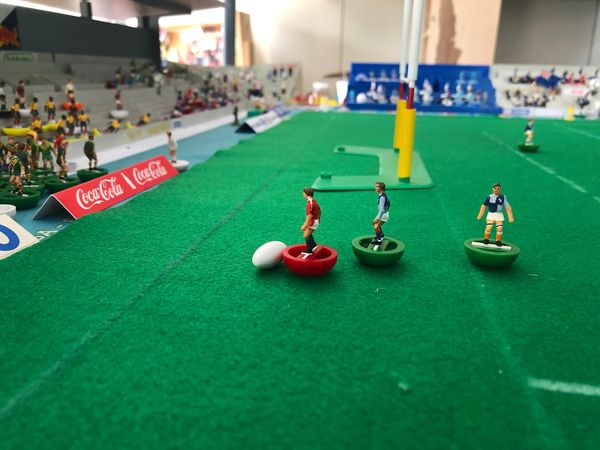
Intimamente siamo tutti innamorati del rugby, anche se pochi ne conoscono le regole. Pochi, pochissimi, forse nessuno le conosce nei più piccoli dettagli. Un giorno, il pilone della nazionale italiana (il più famoso e il più amato) disse che neppure lui conosceva tutte le regole: “per quello abbiamo l’arbitro e lo rispettiamo, perché è l’unico che capisce quello che succede”. Il rugby ci parla di noi, delle nostre paure a confronto di giganti, dei nostri timori quando entriamo in classe per la prima volta alle elementari. Quando prendiamo posto nel nostro banco e ci guardiamo attorno: c’è quello grosso che guarda fuori dalla finestra e il piccoletto con lo sguardo aguzzo (ehi, quello è un mediano di mischia!). In ogni momento difficile della nostra vita ci rendiamo conto che chi ci circonda ha le nostre stesse paure, ma tutti hanno punti di forza e di debolezza differenti. Come nel rugby, come in una squadra di rugby. Fateci caso, nel rugby i ciccioni sono osannati e tutto il gioco passa da loro. Se invece sei alto e un po’ tonto ti mettono sulla schiena il numero 5 e ti dicono di saltare in alto, se non ci arrivi ci sono i tuoi amici che ti spingono da sotto (spesso sono sempre i tuoi amici ciccioni). Quando la natura non ti ha dotato di fisico forte e di altezza stai sicuro che sarai uno di quei piccoletti che vedono le nefandezze dove altri scorgono prati verdi, se sei quel tipo di piccoletto che vede i buchi anche nelle suole delle scarpe dei tuoi avversari l’allenatore avrà finalmente trovato il suo numero 9. In ogni classe di ogni scuola ci sono sempre quei ragazzi magri, quasi gracili, ma che corrono come se avessero il fuoco nei pantaloni. Corrono non per essere più veloci della vita, ma per non essere preda dei bulli, dei ripetenti e di quelli che ci godono in sacco a sporcarti la divisa. I gracili sono veloci, fuggono e si divincolano come anguille. Per questo motivo ricevono la palla e si sentono ripetere: “corri, Forest, corri!”. Sembrerebbe tutto fatto, ogni uomo al proprio posto eppure rimane un bambino seduto in disparte. Uno con la testa reclinata sul libro e che la alza solo se la maestra dice il suo nome. Qualcuno lo chiama “secchione”, i più moderni “looser”. Nel rugby c’è sempre un uomo che, nel momento del bisogno, alza la testa dal suo libro e si prende la squadra sulle spalle. A volte non diresti al tuo amico “ehi, è lui”, ma quando prende la palla e comincia a farla girare storci le labbra e devi ammetterlo. Il numero 10 è proprio uno con le palle.
Tutto questo succede nella vita, sui banchi di scuola, nei capannoni freddi della carpenteria e negli uffici polverosi dove la gente spreca la propria vita. Tutto è gruppo, tutto è sostegno. Tutto è rugby.
Subbuteo Fest 2022 – Australia
We will have a fair so people can buy and sell items, plus we will have competitions:
Subbuteo table soccer competition. 4 pitches. (12 player limit)
Subbuteo table cricket competition. 2 pitches (6 player limit)
Subbuteo table rugby competition. 2 pitches (6 player limit)
painting competition: entries must be submitted beforehand.
All queries to me: info@ozflick.net

Da dove veniamo
Tutti noi proveniamo dal Subbuteo. Siamo nati, cresciuti, ci siamo fidanzati e poi sposati. I più fortunati hanno avuto dei figli e hanno sospirato e sofferto dietro i problemi della vita comune. Però, tutti noi, proveniamo dal Subbuteo. Il panno, le porte, le squadre e migliaia di partite. Di questo dobbiamo ringraziare i pionieri dell’era pre-Subbuteo (ok, questa è una storia che vi racconterò la prossima volta) e il grande creatore: Mr Peter Adolph. Questo signore ha creato il nostro sogno e ha avuto il giusto riconoscimento economico, oltre all’immortalità nei nostri cuori. Nel pieno del boom del Subbuteo, nella patria del Rugby, qualcuno iniziò a chiedere la versione ovale del meraviglioso gioco.
La storia ci racconta questo:
Il subbuteo rugby nasce nel 1950 a seguito dei buoni risultati commerciali avuti dal calcio. Vennero prodotte due confezioni definite Flat anche se l’unica figura flat era il kicker mentre i giocatori erano dei comuni bottoni di plastica rossi e blu dove venivano incollate le figure circolari che dovevano essere ritagliati da un foglio di carta bianco. Le differenze tra i due box erano dettate solo dall’avere il campo o meno, queste scatole saranno l’unica produzione rugby fino al 1968 quando con l’avvento qualche anno prima delle chunky figure si passerа alle figure tridimensionali e a nuove confezioni. Con le figure tridimensionali sono state prodotte 3 confezioni di subbuteo rugby con 4 versioni, le prime 3 chiamate International ma di fatto se paragonate al calcio sono sia nel formato che nel contenuto delle comunissime Club edition. La prima versione ha la scritta NEW e contiene figure chunky raffiguranti quasi sempre squadre della rugby league, nella seconda scompare la scritta new e appaiono le squadre nazionali, nella terza l’inserto è di cartone verde e trovano quasi sempre posto le nuove figure HW, nella quarta edizione (1978) scompare la scritta international, l’interno è di polistirolo e le figure possono essere sia zombie che LW. Quest’ultima versione rimarrà in produzione come per il cricket fino al 1983 quando cesserà a seguito delle scarse vendite la sua commercializzazione. Il catalogo squadre prevede un range di 26 squadre prodotte alternativamente in versione chunky e hw fino al 1978 quando il range viene ampliato fino alla referenza 37 Nelle foto delle squadre ho volutamente messo solo 3 giocatori, rappresentano la prima linea e per un ex-pilone come me è un tuffo al cuore, un omaggio al ruolo più bello che c’è, ovviamente le squadre sono tutte complete.
Ma come si gioca a subbuteo rugby? Onestamente il regolamento originale subbuteo rende il gioco decisamente macchinoso e noioso, è anche vero che il rugby per le situazioni che si creano in campo è un gioco difficile da replicare, ma negli ultimi anni un nutrito gruppo di appassionati ha rivisto il regolamento originale cercando di rendere il gioco più giocabile, vivo e quanto più possibile fedele alla realtà e in Italia, anche se molto lentamente il movimento stа crescendo con la creazione di sezioni rugby nei vari club sparsi per lo stivale.
Esistono anche delle rare versioni LW, c’è una versione winged short fatta solo con i colori del Galles (chissа perchè) e alcune varianti.
Del rugby sono state prodotte anche delle versioni “seven” ossia di rugby a 7, la prima prodotta dal 1971 si chiama display edition con inserto marrone e veramente carina esteticamente, mentre la seconda versione si chiama rugby seven e ha l’interno in polistirolo, fu prodotta prima con le hw e le chunky mentre l’ultima venne prodotta con le zombie.
Dal vuoto e dal buio emergiamo noi. Un gruppo di persone che in questa fase mi limiterò a chiamare “i nuovi pionieri” si sono ribellati. Nei primi anni 2000 internet ha permesso l’incontro tra questi pionieri che hanno unito la passione del Rugby con il meraviglioso gioco. Si sono chiesti “perché nessuno gioca più a Subbuteo Rugby e perché è fallito nonostante il Rugby sia così diffuso nel mondo?”. La risposta unanime è stata: il regolamento.
Giocare con il regolamento originale era impossibile, riuscire a fare metà una pia illusione. Sono state avanzate varie idee, alcune scartate subito, altre approfondite. Nel 2009, nella splendida cornice di Affi (VR) si è giocato un primo torneo con le nuove regole. 16 giocatori, entusiasmo alle stelle e finale con il rispettabile risultato di 13-10. Chi ha vinto non è importante, ci sarà tempo per i nomi. Sono seguiti altri tornei, altri progetti e altre storie. Nei prossimi appuntamenti parleremo un po’ dei “pionieri”, dei materiali e del regolamento.
Ovviamente vi parleremo della nostra casa. Il sito www.tablerugby.com
France v. Scotland – Full Match Video
I had some time this week to play a few games and for one of them, I recorded the action. I think it gives a decent idea of how the game can be played.
The 1st Half:
The 2nd Half:
Principles of Play – Subbuteo Rugby My Way
INTRODUCTION
Subbuteo Rugby is a challenging table-top replica of rugby. The game can replicate either Union or League when appropriate variations to playing procedures are applied. In this document, I focus exclusively on Rugby Union. A second document that focuses on League is forthcoming.
My objective with this document, or guide, is to explain how I play Subbuteo Rugby using a combination of the original Subbuteo Rugby rules of play, modifications made by members of the Italian rugby-playing community, the real Laws of Rugby, and my own subsequent modifications. This is a personal approach which I enjoy. It is my intent to pass along my experiences to others with an interest in playing, either as starters or as long-standing participants, so that we may share ideas and information and get as much enjoyment as possible from this excellent pass-time.
I have organised the guide to demonstrate the key elements of the main phases of rugby play. Each phase is linked to a tutorial video that is available on my YouTube channel.
GENERAL PRINCIPLES OF PLAY
The game is played under the auspices of the real Laws of the Game. As such, actions, events and their consequences link directly to those stated in the Laws. However, the technicalities of the Laws and the difficulties of playing mauls and rucks, for instance, means that many playing principles in the real game are not replicated by Subbuteo. Or at least, for now. Part of the development of Subbuteo play is to find innovations that bring the game even closer to the real experience.
Nonetheless, the primary objective of Subbuteo Rugby is the same as real rugby– for one team to score more points than their opponent. To do this, the team carrying the ball must legally move it into the opponents’ in-goal or kick successfully through the goal posts.
To do this in Subbuteo requires that the playing figures of the attacking and defending teams are moved around in a reasonably realistic way. The team in possession has an unlimited number of touches of the ball until they lose possession. Subbuteo’s original rules recommend that for every touch of the ball made by the attacking side, the defending side gets one (1) defensive flick to block the progression of the attackers but without touching the ball or otherwise interfering with play. This works best when the game is played by 2 players (humans) but for solo play it becomes a little cumbersome.
At this point I will highlight the first major modification to the original rules that I have introduced to my play. I give 3 flicks to the player on the attacking team that has possession before giving 1 flick to the defending team. I find this allows the attacking team to properly get the ball under control while preventing defending players from “crowding” the ball carrier. The defending figures now have to be moved more strategically to block the attacker. In addition, the attacking team can also make more ground before any defending pressure can be applied, thereby recreating the real experience of the attackers being on the front foot and the defenders being on the back foot. Overall, I find this makes for a faster game.
With this in mind, let’s look at each of the structural elements of Subbuteo Rugby.
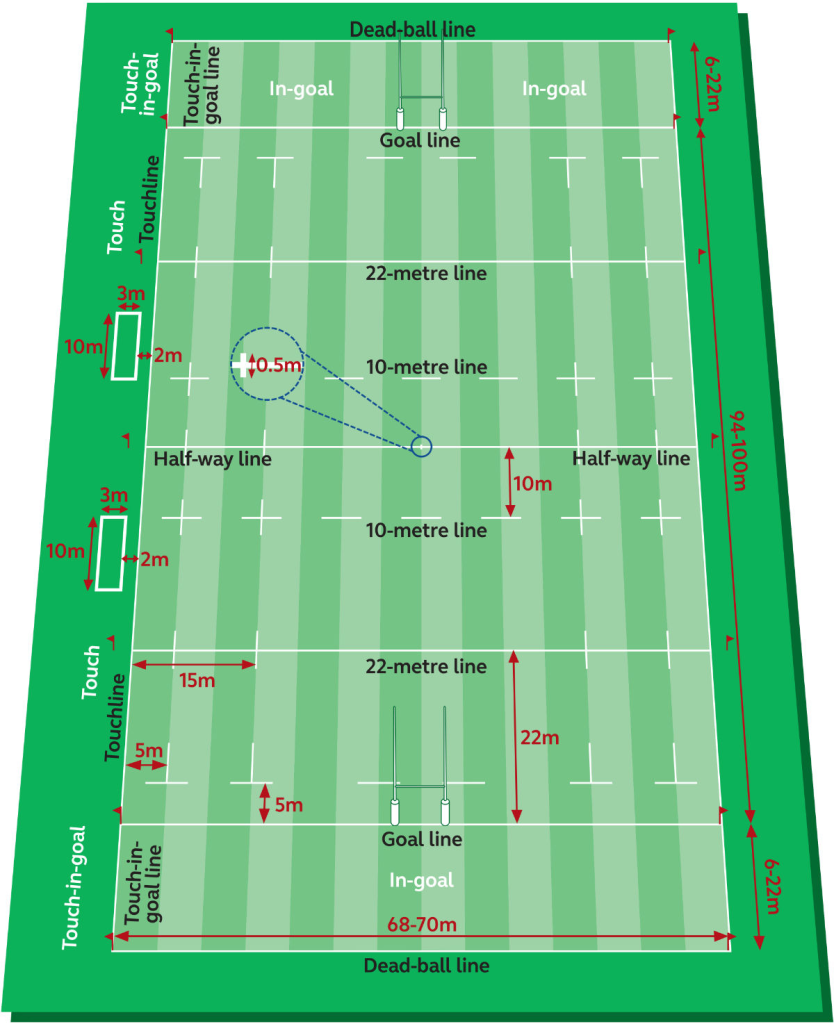
Source: https://www.world.rugby/the-game/laws/law/1
DURATION & TIME-KEEPING
The game has 2 halves, each of which lasts for 20 minutes. The clock is stopped to allow for players to be moved for setting up scrums and line-outs, and repositioning associated with penalties and restarts. Each half ends as it does in real rugby, with play continuing into the red-zone (ie. after the final official minute has ended) until play is dead – see Law 5.
KICK-OFF & RESTARTS
Each half starts with a kick-off taken from the centre spot at mid-field. Kick-offs also restart the game after a score. This may be performed by the kicking figure or by using the kicking wedge. The choice is yours.
The kick-off is legal when the ball remains within the field of play and has travelled across the 10m line. A kick that lands between the 10m line and the 22m line without being touched by the receiving team is still in possession of the kicking team who may flick a figure to the ball. They keep possession if they touch the ball; if they do not, the receiving team may attempt to touch the ball with one of their figures. Should they miss then the kicking team may try again.
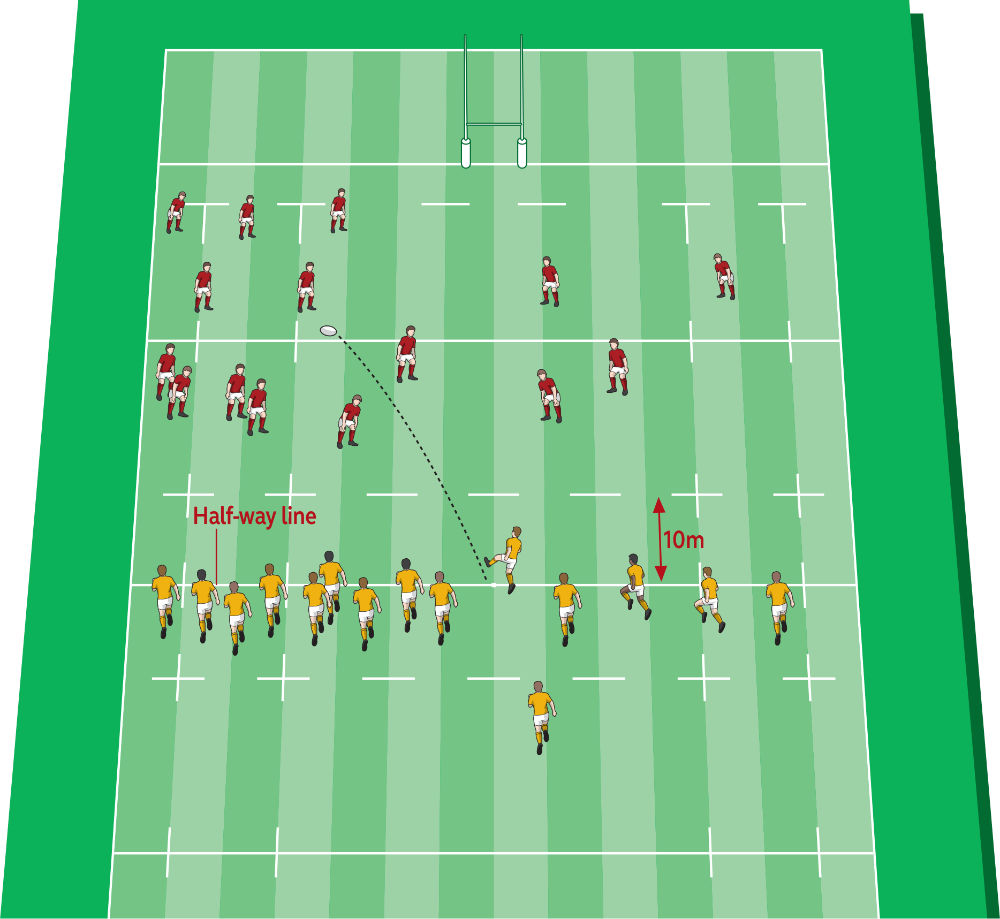
Source: https://www.world.rugby/the-game/laws/law/12
A ball kicked across the the 22m becomes the possession of the receiving team and they can bring it out as they see fit. If they fail to touch the ball with their flick the kicking team may attempt to gain possession by flicking one of their figures to touch the ball.
When the kick-off fails to travel across the10m line, or goes through the in-goal or goes directly into touch, the receiving team has the option to allow a re-kick, take a scrum at the centre spot, or take a line-out. The choice is entirely dependent on the advantage offered to the receiving team and their overall strategy. For example, a kick-off that crosses the touchline deep in the 22m zone could be accepted as a line-out to the receiving team. However, this would put them at a disadvantage and a scrum on the centre spot would give better field position.
KICK TO GAIN GROUND
Kicks to gain ground, either to move the ball forward out of the defensive zone or to move the ball quickly into an attacking area (the old up-and-under) are performed using the kicking wedge. To be legal, the closest defending player must be more than 2.5cm (long-side of kicking wedge) away from the ball in the direction of the kick. Call ‘kick” put the wedge in position and flick/kick away. Playing figures from either side may be moved by flicking, either to cover the kick or to come back from offside positions. No limit on flicks for this procedure.
Other kicks, either drop-outs from the 22, or from the goal-line, if the ball has gone dead in the in-goal, area all governed by the real Laws (Law 12 and Law 21).
PASSING & POSSSESSION
As previously stated, the attacking side gains possession by initially touching the ball. The total number of touches is unlimited until possession ends. While in possession, I allow 3 touches to control and move the ball forward before the defending side can make a covering flick. I continue this 3-to-1 ratio throughout the period of possession. The ball must remain within 2.5cm of the ball carrier in order for possession to be maintained.
However, an exception I play is that if a touch of the ball sends it beyond 2.5cm, the carrier is still considered to be in possession but must touch the ball with the next flick. If this happens, ball and figure must keep within the 2.5cm limit. If not, or the ball is missed, then a knock-on may be called. If the defending team feel they can attack from this point, they can carry-on. If they do so, then they are doing so under the Penalty Advantage rule (Law 7), meaning that if they end up not gaining anything from the advantage call, play may be halted and the defending team receive a scrum at the point where the original knock-on occurred (who said rugby was simple!).
Passes may be made at any time. A pass is a flick against the ball that sends it backwards or parallel to an imaginary line that is perpendicular to the touch-line. If the ball goes towards the opponents goal then it is a forward pass and is penalised accordingly (Law 11).
A player may also “hand-off “a ball to a team-mate. For me this means that the ball is legally to the side of the ball carrier when one of his team-mates from behind is flicked to the ball to move it forward. This replicates what we often see in the real game where a full-back, for example, sprints from the back and “bursts” through the defensive line.
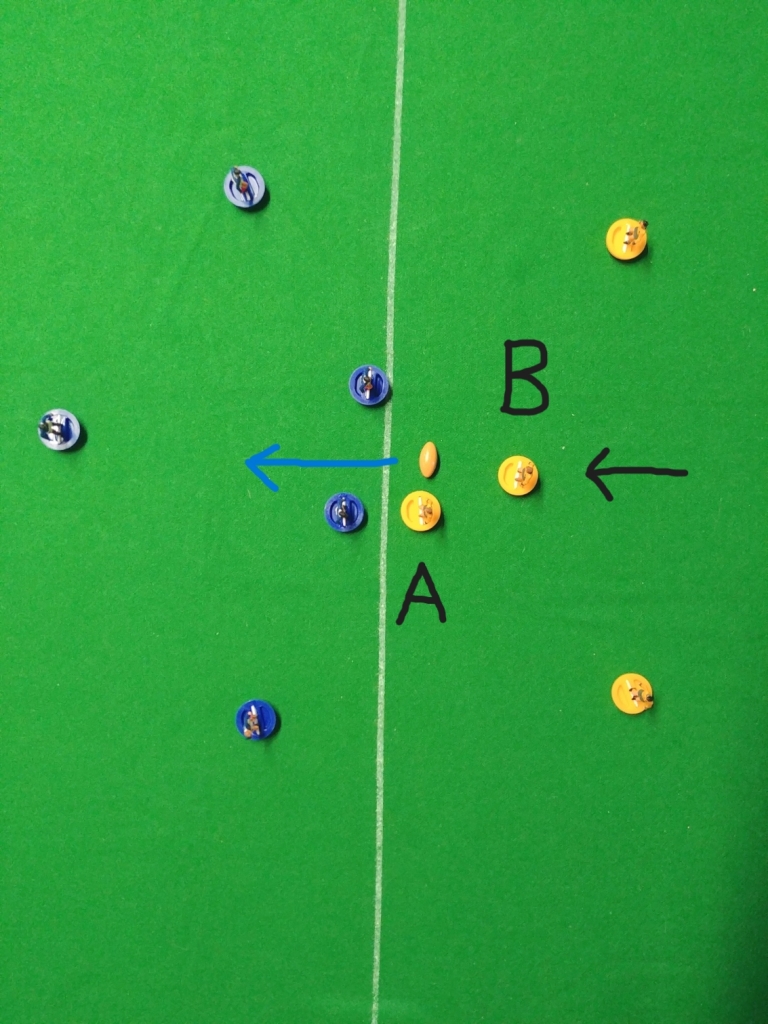
At times, however, the attacker becomes “surrounded” by defenders. To escape such situations, the attacker can call “Pass”. When called, each side may take up to 5 positioning flicks and the defenders around the attacker are moved back 1cm to free space for the attacker’s pass. The attacking team continues their possession when a legal pass is performed.
TACKLING
Tackling always seemed to me to be one of the most confusing aspects of Subbuteo Rugby – when is a tackle not a tackle and why does a Subbuteo “tackle” look nothing like the real thing? Well, to be fair, we have to reconfigure our minds to accept how Subbuteo tackling works. Basically it represents a change-over of possession when the attacking team flicks the ball against an opponent, thereby losing possession just like in Subbuteo Football.
“Tackles” and subsequent turnovers are also made when the attacking team fails to touch the ball and the defending team then makes a touch and claims possession.
ATTACKING & SCORING
The purpose of the game is to score. Law 8 specifies the points scored for tries, conversions and kicks.
A try is scored by legally moving the ball forward to get into the in-goal, or to touch the goal-line. The attacking player who puts the ball in either of these positions must then touch the ball and keep it within the 2.5cm limit to score. If the flick is too strong and the ball travels more than 2.5cm, then a try is not scored and a knock-on is ruled, with a scrum to the defending team.
When a try is scored, the attacking team attempts a conversion kick. The kick is taken from a position as described by Law 8: “on a line through the place where the try was awarded, parallel to the touch-line.”
A drop goal may be attempted at any time. The attacker calls “Drop” and then may attempt the kick using the kicking wedge. However, the drop attempt is only allowed if all defending players are more than 2.5 cm from the ball at the time of the call for a drop. Scoring is per Law 8, and a miss requires a restart described in Law 21.
SCRUM
Scrums are awarded to restart the game for various reasons. Although I consider the “Scrum Machine” a clever and innovative way to include this aspect of rugby into the Subbuteo version, I prefer the method adopted by the Italian Subbuteo community. It just seems more aligned with the game and less gimmicky or “toyish”.
As per the video description players are arranged in the 3-4-1 formation either side of the mark and the put-in is made by the scrum-half. Possession is determined by which team the ball touches or is closest to after the put-in, and play continues with the respective scrum half taking possession or passing from behind the No. 8 (the 1 in the 3-4-1).
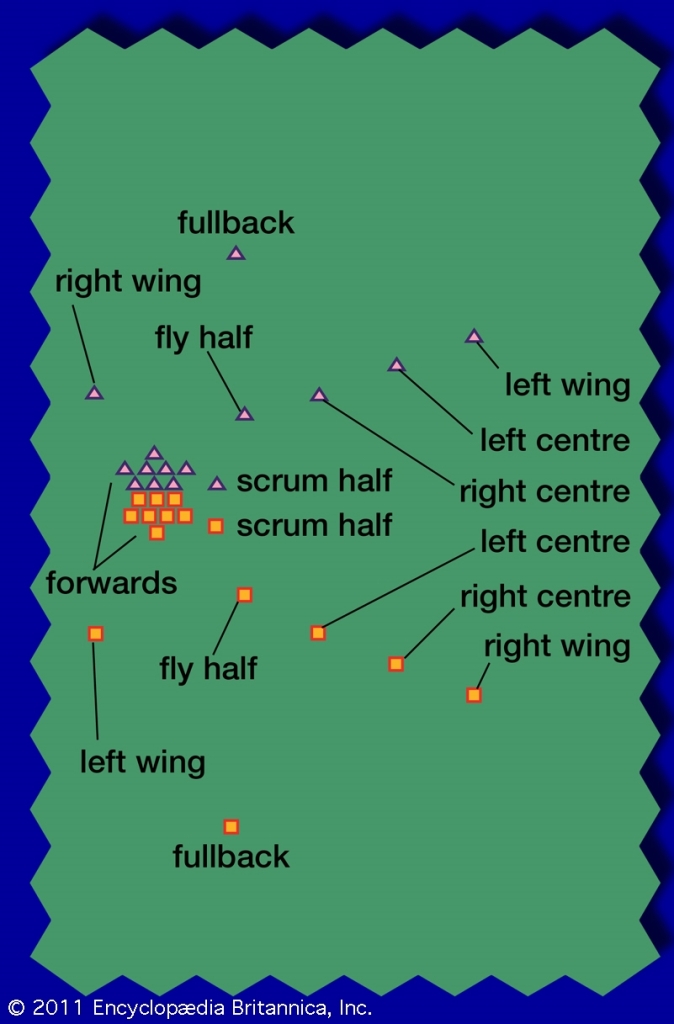
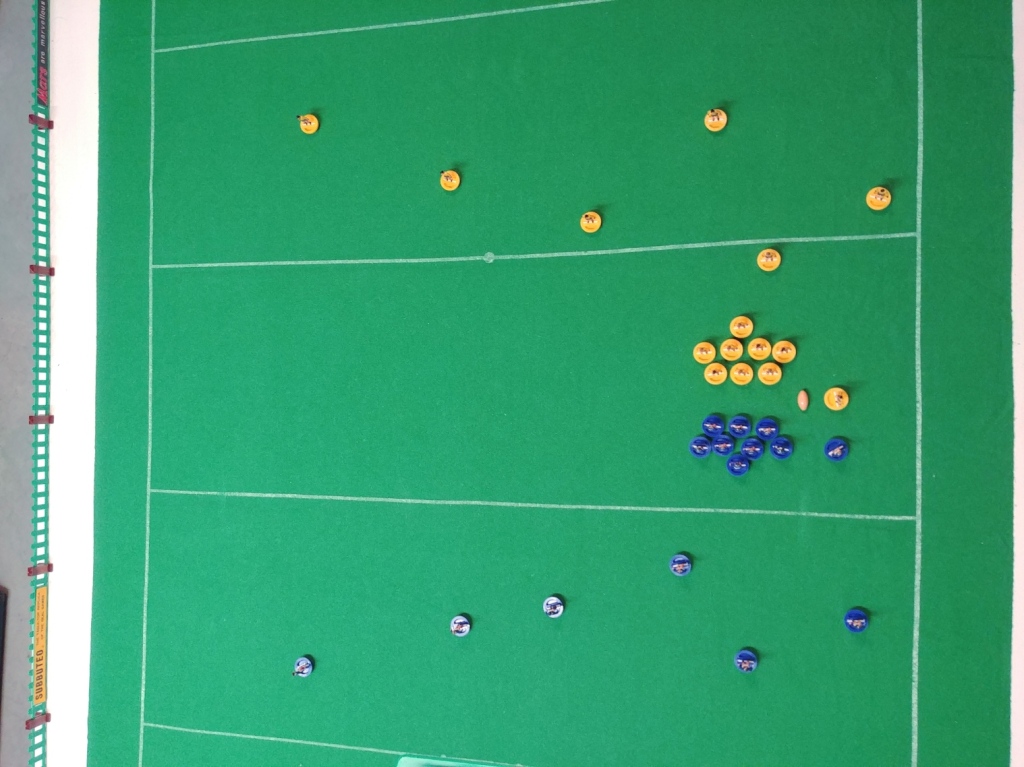
If desired, once the scrum is completed, up to 5 players from each side may be flicked away from the scrum. I find this a little time consuming for solo play, although I do sometimes apply this option.
LINE-OUT
The line-out is also a way to re-start the game but applies only to balls that have crossed the touch-line. Players are arranged per the video. The team winning possession from the throw is the one touched by the ball or closest to it. Play continues from behind the player touched or closest to the ball.
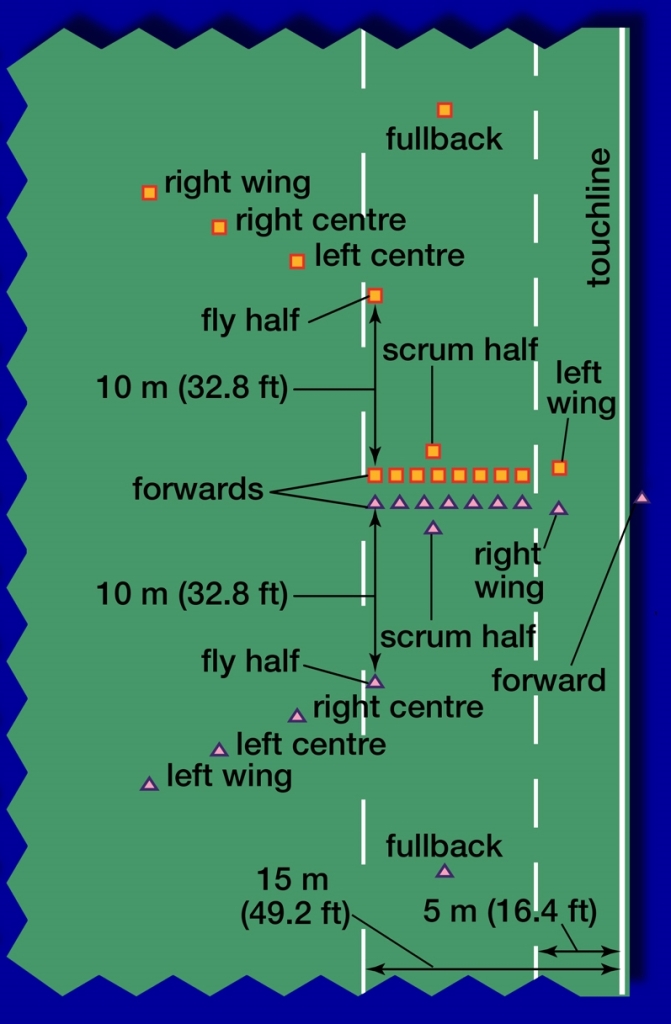

Again, this is a modification from Subbuteo’s original rules which required the ball to be “thrown” by placing the ball on the thrower’s base and manually throwing the ball. Either approach works; it’s up to you.
If desired, and similar to the end of scrums, an option to apply repositioning flicks for up to 3 players is available.
OFFSIDES & FOULS
Real rugby has a number of very technical rules which create frequent penalty decisions during the course of game. Many of these situations cannot be replicated in Subbuteo Rugby. But some can and here’s how I include them.
a) Offside
Any players from the same team who are closer to their opponent’s goal than the ball are offside and must be flicked and re-positioned as soon as possible. Should the ball touch an offside player after a flick by a team-mate, a penalty is awarded.
b) Fouls
A penalty is awarded when:
- an attacking support player hits a defender;
- a defender flicked to block hits an opponent including the ball carrier.
A “Back”, which is the replacement of an offending player to its original starting position, is awarded when a defending player is flicked and touches the ball but not the opponent.
c) Obstruction
Obstruction is when a player is between the ball and an opponent, preventing the opponent from having a direct flick at the ball. This is called “Static Obstruction” and offending players are to be flicked aside without conceding a blocking flick.
Deliberate obstruction is when a player is deliberately flicked between the ball and an opponent, preventing a direct flick at the ball. This is not allowed and is a penalty.
(Note: in older versions of the Subbuteo rules, this was allowed and required the attacking team to “spin” their player around the defender to the ball. For me, this slowed the game down too much and created an unrealistic number of turnovers).
As with defending players, attacking players must not be used as blockers for the ball carrier – this is Crossing and results in a penalty.
CONCLUSION
Subbuteo Rugby is a challenging game that, with some thought and a great deal of sharing of ideas, provides an excellent recreation of the real game. My journey has crossed many paths and I have used my experiences to develop a series of tutorials about the main elements and phases of the game. Rather than rules, we have principles of play, principles that I hope help players learn and develop their games. Play on!
Playing Subbuteo Rugby – Part 2
In Part 1 I presented several videos of highlights from a selection of recently played solo rugby games. In this blog-post I am pleased to present a full game – New Zealand v. South Africa. It’s in 3 separate videos to accommodate the size of each file but you can watch them in sequence to enjoy the full match.
Part 1
Part 2
Part 3
Playing Subbuteo Rugby – Part 1
In this blog post, I’d like to present some action from several matches I’ve recently played. From time-to-time I make video recordings of games. I use these to help me better understand the game, the application of it’s (my) rules, and to potentially find ways to make improvements.
There’s usually no audio commentary, just text comments to describe the key action. By publishing the edited versions, I also hope to demonstrate to players of all types, from beginners to the “old hats”, how Subbuteo Rugby can be an enjoyable way to pass a free hour or so.
We’ll start with highlights from a clash between Scotland and England:
Next, it’s France taking on Japan:
And now it’s Japan, again. This time against Argentina
And finally, for this blog, here are highlights from a match between Wales and Scotland